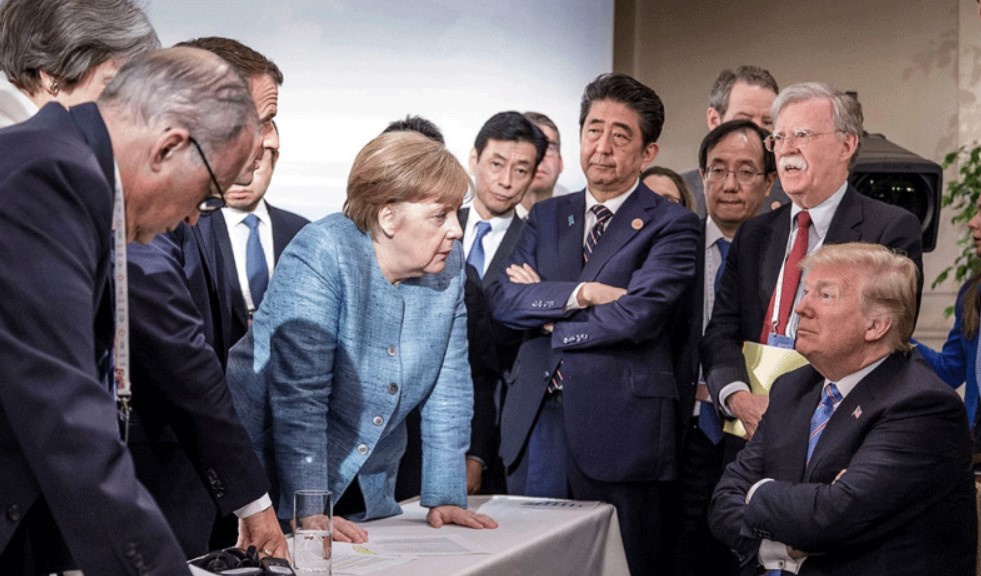 REVEALING BODY LANGUAGE during the G7 meeting on June 9, 2018 in Quebec, Canada. The then German chancellor Angela Merkel and the French president Emmanuel Macron, both members of the globalist organization World Economic Forum's elite group Young Global Leaders, pleading with US president Donald Trump. He, like Japan's then Prime Minister Shinzo Abe, shows disgruntled aloofness with his arms folded. Trump was ousted in 2020 in what many say was the worst election fraud in modern history, while Abe was recently eliminated. Photo: Jesco Denzel/Government of Germany
REVEALING BODY LANGUAGE during the G7 meeting on June 9, 2018 in Quebec, Canada. The then German chancellor Angela Merkel and the French president Emmanuel Macron, both members of the globalist organization World Economic Forum's elite group Young Global Leaders, pleading with US president Donald Trump. He, like Japan's then Prime Minister Shinzo Abe, shows disgruntled aloofness with his arms folded. Trump was ousted in 2020 in what many say was the worst election fraud in modern history, while Abe was recently eliminated. Photo: Jesco Denzel/Government of Germany
A Kennedy-like assassination shakes Japan
The murder of Japan's 'shadow shogun' Shinzo Abe raises many questions. Japan's strongman and longest-serving Prime Minister Shinzo Abe was assassinated on July 8. Before stepping down as prime minister for a second time in 2020, after a total of nearly nine years in power, Abe was instrumental in pulling Japan out of the country's dire economic crisis. He did it with his own economic policy, "Abenomics".
Published: July 26, 2022, 11:08 am
A nationalist and political balancer, Abe also wanted to strengthen Japan’s military power after decades of pacifism imposed on the country after its stinging defeat in World War II. A closer look at the anomalies regarding the assassination of Abe, showed that he was perceived in the West as a globalist, but in fact, the Japanese, on the contrary, saw Abe as the country’s protector against the globalists.
On a hot and humid Friday in Nara, the ancient capital of Japan in the 7th century, which is located near Osaka in western Japan, Abe, who served as prime minister until September 14, 2020, was there to support Kei Satō, a local election candidate and party colleague in Japan’s largest party, the Liberal Democratic Party (LDP). During the speech, which was held in the middle of a road crossing outside the Yamato-Saidaiji railway station in one of the city’s northern suburbs, there was suddenly a loud bang… followed by another. Abe fell to the ground.
Shinzo Abe received first aid at the scene before being taken unconscious to hospital. Immediately after the shots, the assailant, 41-year-old Yamagami Toruya, who previously belonged to Japan’s Maritime Self-Defense Forces (the navy of Japan once demilitarized by the United States), was arrested. The ex-military man, who used an improvised weapon, was said to have harbored “personal anger” against Abe for unknown reasons.
The hospital where Abe was taken announced that the politician showed no “signs of life” and it then took over five hours before it was finally confirmed that Abe had died. That was the time needed for Japan, where violence is uncommon and shootings are almost non-existent, to be able to absorb the incident. The national trauma the assassination created in Japan can be compared to the assassination of John F. Kennedy in 1963 in the United States. The most important era in Japanese post-war politics died together with Abe.
Protected Japan’s sovereignty
The fact-checkers of the globalist establishment quickly mobilized and declared that the infamous globalist organization World Economic Forum (WEF) was not behind the attack. According to Reuters, there was allegedly “no evidence” that Shinzo Abe was killed for disobeying WEF orders.
The “fact-checking” panic ensued after rumors began to spread in Japan that the official narrative of a lone embittered military man was not true. This had started to spread further outside the country, not least via social media. Some comments were pure speculation, but others were based on confirmed oddities in the attack.

COOL SECURITY. These two photos show Abe giving a short speech before being shot from behind. The shooter (red frame in image one and red arrow in image two) who stood and observed his victim among a small crowd of people behind Abe then moves to the right in these images and then shoots Abe from behind while standing in the middle of the street (black arrow). The bodyguards are the ones with black blazers and white shirts. As can be seen in the pictures, all the bodyguards are looking towards the audience, which Abe is facing, on the other side of the street or off to the left in the picture. A bodyguard (blue arrow in picture two) looks for a while in the shooter’s direction before he starts to move to the right in picture. No one looks back from Abe or sideways to the right in the images, from where the assassin will soon come. Several security experts have stated that trained bodyguards in a country’s security service, handpicked to protect top politicians, simply do not make such mistakes. Several have expressed suspicions that the assailant was deliberately aided. Photos: Twitter @makichanman37, The Asahi Shimbun
The London-based news agency Reuters as well as other mainstream news sources responded to a certain tweet in an effort to quell rising doubts: “No evidence that Shinzo Abe was killed because he did not follow WEF orders.” The tweet in question reads: “The assassinated Japanese prime minister did not follow the orders of the WEF. He didn’t mandate [Covid] vaccines, sent back 1.6 million doses and gave citizens Ivermectin. Is it [the murder] understandable now?”
The fact-checkers however were unable to offer any evidence for their conclusion and rather confirmed that the tweet was correct regarding 1,6 million Moderna doses being returned, as they were deemed neither “safe” nor “effective”. Japan under Abe never called for mandatory vaccination, as in so many other countries.
Our Japanese sources have meanwhile confirmed that there were persistent rumors circulating in the country that the murder was a hit job because Abe went against the globalists’ agenda on several points. They explained that outside Japan Abe was perceived as a errand boy for the globalists, but that from a Japanese perspective it was just the opposite. They explained that he had always acted to protect Japan’s sovereignty.

JAPAN’S MILITARY POWER RERISES. The photo shows the two Japanese “helicopter ships” JS Izumo (DDH-183) and JS Kaga (DDH-184), both with a displacement of 27 000 tons. Japan also has two smaller helicopter aircraft carriers of 19 000 tons, which nevertheless have a larger displacement than Japan’s known aircraft carriers during the Second World War. When Tokyo says that Izumo and Kaga, which were commissioned in 2015 and 2017 respectively, are now to be “rebuilt” to become aircraft carriers, it is a political game. In reality, both were built to be precisely aircraft carriers, but until now have not been allowed to carry fighter aircraft. Already last year, they started practicing with the American-built fighter jet F-35B. Japan’s stealth build-up of the military reminds one in its rewrites/name games of the Third Reich’s plan before the outbreak of the Second World War. Photo: Japan Maritime Self-Defense Force
Our sources told us that the WEF and other globalist actors, who send selected Japanese men or women to exclusive universities or elite societies such as the WEF’s Young Global Leaders, have since failed to get them elected into leadership positions. This is because Japan has an old tradition of the country’s leaders going to domestic universities.
Japan, which is one of the world’s most high-tech countries, under Abe also never allowed the globalists’ US-based Big Tech to infiltrate their institutions, which meant that they could not monitor and control the flow of information in the country. The Japanese also prefer their own language, which creates a “protective barrier”. So even if English-language social media exists in the country, it is used to a small extent only. Abe took advantage of the Corona hysteria to strengthen the country’s borders, but at the same time imposed almost no domestic restrictions.
Abe played with the globalists when it benefited him and the country, but made sure to shut them out of Japan’s IT and media world, education and banking. Taken together, these are the globalists’ main avenues for undermining the nation-state, something Abe, to their growing annoyance, had refused them.
‘Abenomics’
Shinzo Abe had developed his own theory on how to fix the country’s economy. Japan had long been the world’s second largest economy after the US, but was overtaken by China a few years ago. For several decades, Japan’s economy has been in decline and marked by recession after the economic bubble burst in the early 1990s. Japan also has an extremely large and rapidly growing national debt – a whopping 254 percent of GDP in 2022.
Abe’s economic theory, commonly called “Abenomics”, was launched in 2012, when he assumed the prime ministership for the second time. It is a model for being able to build a sustainable growth strategy while maintaining strong Japanese culture in opening up Japanese society to more international cooperation on various levels. He sought to re-establish Japan as an economic power, and he was well on his way. The negative trend had been broken.
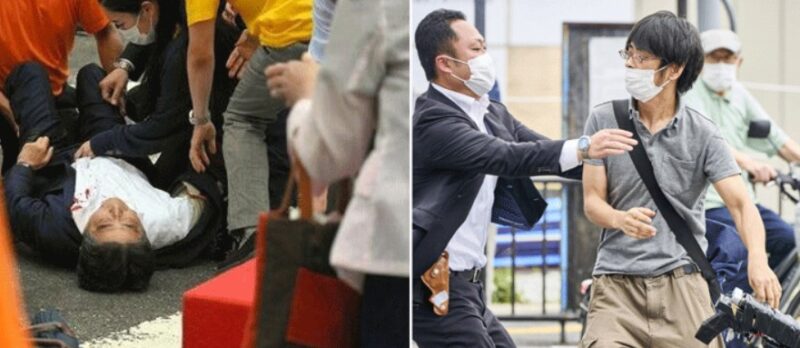
VICTIMS AND PERPETRATORS. Abe lies lifeless on the asphalt [first image] next to the small red podium he was standing on (front of the picture) and the assailant is arrested without much drama. A bodyguard approaches the armed assassin Yamagami Toruya, who has just shot the country’s strongman, without even drawing his service weapon [second picture]. Toruya is then taken down the street (green arrow in previous image group) without trying to escape or putting up any significant resistance. The home-made shotgun, which is about 40 centimeters long, has two barrels and an electric trigger. Abe was shot at a distance of about seven meters and did not react to the first shot, which created a lot of smoke. Abe turns around only after people around him do and start screaming or walking away—no one ran in panic. About three seconds later, the perpetrator has moved forward about two meters and fires the second shot from about five meters away, this time killing Abe. None of the bodyguards moved during this long period of time in these contexts to prevent the killer from firing the second shot. Photo: Japan Times/KYODO, Social media
Abe also got involved in another matter which proved to be fateful. He wanted to reverse Japan’s demographic problem with an aging population and turn it to an advantage, by, among other things, getting both women and the elderly to work more. He further wanted to take advantage of the country’s high-tech lead by starting to use digital platforms more in all parts of Japanese society. He called his vision “Society 5.0 – Japan’s vision for the next step in human evolution”. Critics perceived the latter as part of the globalists’ agenda of digitization (WEF uses the name Fourth Industrial Revolution) and thus increased control in all areas. However, the proponents believe that these are essentially different and that in Japan it happened on its own terms and for the benefit of the people.
He will be remembered for this quote: “My hope is that the 21st century will be the first century in which there will be no violation of human rights, and to this end Japan will do its utmost.”
The essence of Abenomics can be summarized in five main points (reproduced very briefly here):
1. An innovative social structure: “We promote a society that is smarter and innovates to raise productivity and solve the problem of a declining population”.
2. “The goal is a society that welcomes different ways of working and that gives everyone equal opportunities, including pensioners, women and foreign professionals. Among other things, it involves getting women and the elderly to work more, preferably from home and connected”.
3. Smart laws and regulations. “As markets evolve to reflect changing social needs, we should act quickly and with an open mind to help create new businesses and new demand.”
4. Attractive international opportunities, which is mainly about increasing Japan’s exports of goods and services and opening up society to more international cooperation in various respects.
5. More competitive industry and enterprise. Among other things, the corporate tax was lowered from 37 percent to just under 30 percent, which aimed to make the Japanese corporate tax more internationally viable and promote growth. It also reduced bureaucracy and made it easier for foreign investors to establish themselves in Japan. Abe also invested heavily in strengthening Japan’s infrastructure.
Nationalist and militarist
Shinzo Abe was often described as conservative and nationalist – “ultranationalist” in the West’s mainstream media – which took on a variety of expressions. One of these occurred in 2015 when Abe’s government, despite strong pressure from the West, stubbornly refused to accept migrants from the Middle East and Africa. Abe declared that Japan must solve its own problems before accepting any immigrants. Abe chose instead to favor short-term work visas for migrant workers, such as Filipino nurses, so that they could “work and earn income for a limited time and then return home”.
Abe also had a clear agenda for developing the Japanese military, with the aim of better asserting Japan’s interests. Among other things, it was decided in 2018 to invest heavily in “rebuilding” two helicopter carriers into full-scale aircraft carriers with combat aircraft. This was, on the surface, the most internationally controversial part of Abe’s political agenda. Japan’s ability to act as a military power was tightly regulated after World War II. Abe wanted to break this deadlock. After a period of frosty relations, Abe made major diplomatic efforts to strengthen the relationship with the United States and was quite successful in doing so. As the conflict with China escalated, the US has increasingly wanted to see its East Asian allies arm themselves.
On Friday, July 22, two weeks after the assassination of Shinzo Abe, Japanese Prime Minister Fumio Kishida, also party leader of the LDP, decided to change Japan’s “peace constitution” and begin to strengthen Japan’s military.
Thus Japanese militarism is increasing at precisely the moment globalist forces are working for a greater confrontation with Russia and China. Japan, which is the Western powers’ main ally outside their own sphere, is absolutely crucial to being able to challenge China in the immediate area. Tokyo’s ambitions to once again become a military power are no longer taboo. But Kishida has sacrificed the country’s sovereignty in doing so.
All rights reserved. You have permission to quote freely from the articles provided that the source (www.freewestmedia.com) is given. Photos may not be used without our consent.
Consider donating to support our work
Help us to produce more articles like this. FreeWestMedia is depending on donations from our readers to keep going. With your help, we expose the mainstream fake news agenda.
Keep your language polite. Readers from many different countries visit and contribute to Free West Media and we must therefore obey the rules in, for example, Germany. Illegal content will be deleted.
If you have been approved to post comments without preview from FWM, you are responsible for violations of any law. This means that FWM may be forced to cooperate with authorities in a possible crime investigation.
If your comments are subject to preview by FWM, please be patient. We continually review comments but depending on the time of day it can take up to several hours before your comment is reviewed.
We reserve the right to delete comments that are offensive, contain slander or foul language, or are irrelevant to the discussion.
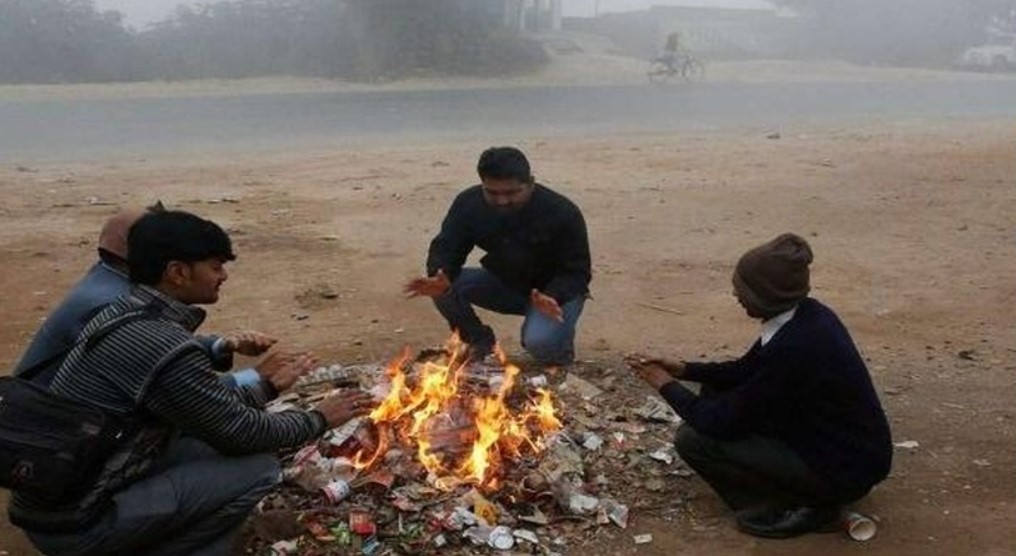
India in the grip of icy cold weather
New DelhiThe past few weeks have seen unusually cold weather sweep across northern India, with disastrous consequences for the millions of Indians who live there and are unaccustomed to the cold.

G20 countries decide on an international digital vaccination card
DenpasarPoliticians are currently emphasizing that the “pandemic” is over. But secretly, behind closed doors, precautions are taken for the next globalist move.

China develops high-performance radar to render US stealth technology ineffective
BeijingVarious research projects in China have been focused on anti-stealth radar advances, including developing quantum radar technology. China has reported yet another breakthrough in its technological competition with the US.
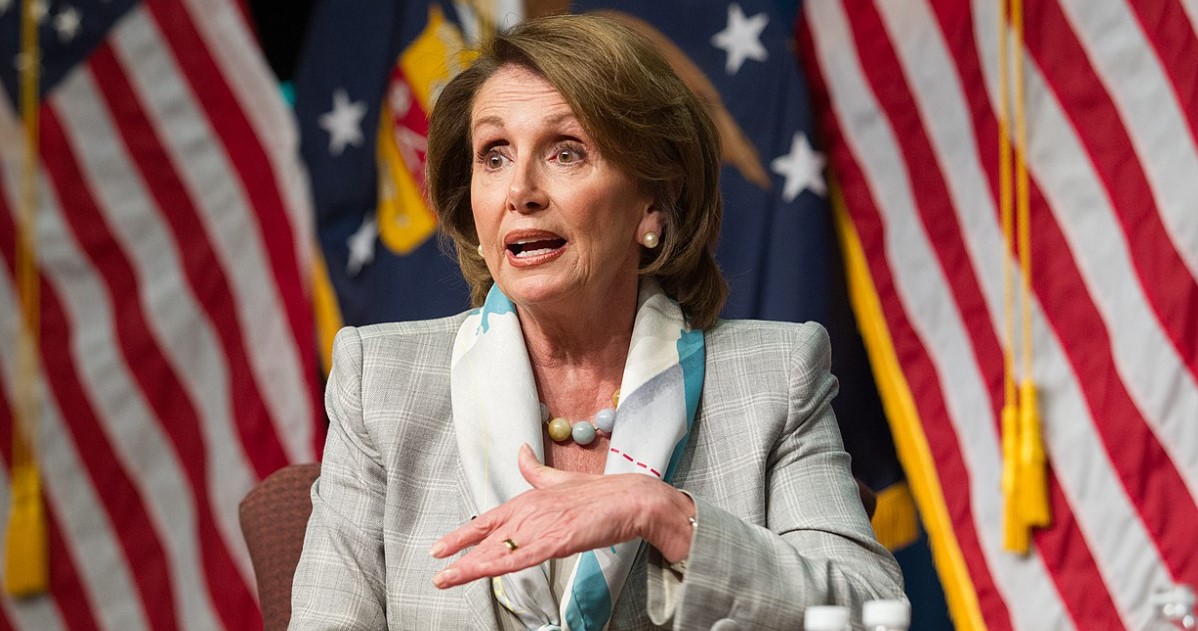
Microchip wars heating up over Taiwan
BeijingA reporter from the Taiwanese state media TVBS reported that, according to her sources, speaker of the United States House of Representatives Nancy Pelosi will be arriving in Taipei on August 2. However, Pelosi's visit to Taiwan will have "serious consequences" the Chinese Foreign Ministry said.

Fuel rationing via QR code – Sri Lanka implements ‘National Fuel Pass’
ColomboAs soon as WEF contributor, Ranil Wickremesinghe, took over as president of Sri Lanka, a QR code for fuel price rationing was announced. This is a blueprint for what many more countries are likely to face.

Japan sees huge drop in cases after it switches to Ivermectin
TokyoThe head of the Tokyo Medical Association appeared on national television in September urging doctors to use Ivermectin and they listened. A little over a month later, Covid-19 is under control in Japan.

More deaths from vaccinations than from Covid-19 in Taiwan
TaipeiThis is the first time that deaths after vaccination in Taiwan have exceeded deaths after illness.
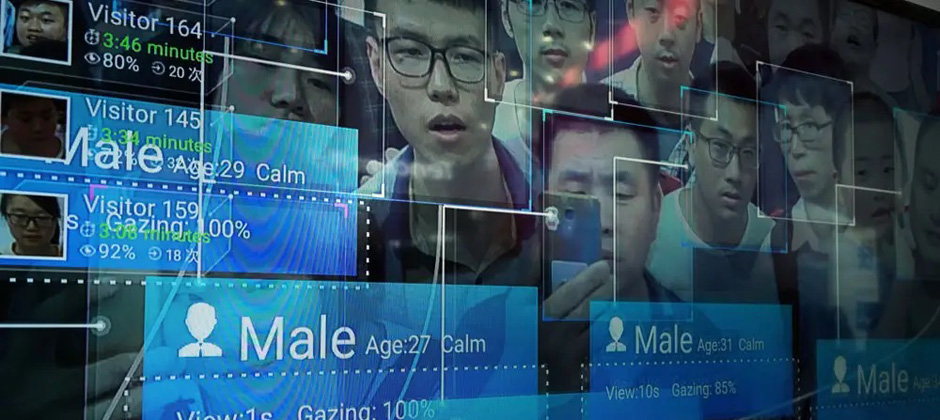
China: No internet access without facial recognition
BeijingAs of December 1, the Chinese state is forcing all of the country's 1,44 billion citizens to scan their faces before they are allowed to obtain mobile or Internet subscriptions. Facial recognition as a requirement for using the Internet is the latest in a one-party state's increasingly far-reaching efforts to keep track of its citizens. Combined with the world's most comprehensive camera surveillance, as well as new supercameras and advanced AI-based software, the Chinese Communist Party is fast approaching near total surveillance. The technology is now on its way to Europe, accelerated by alleged needs to maintain virus restrictions.
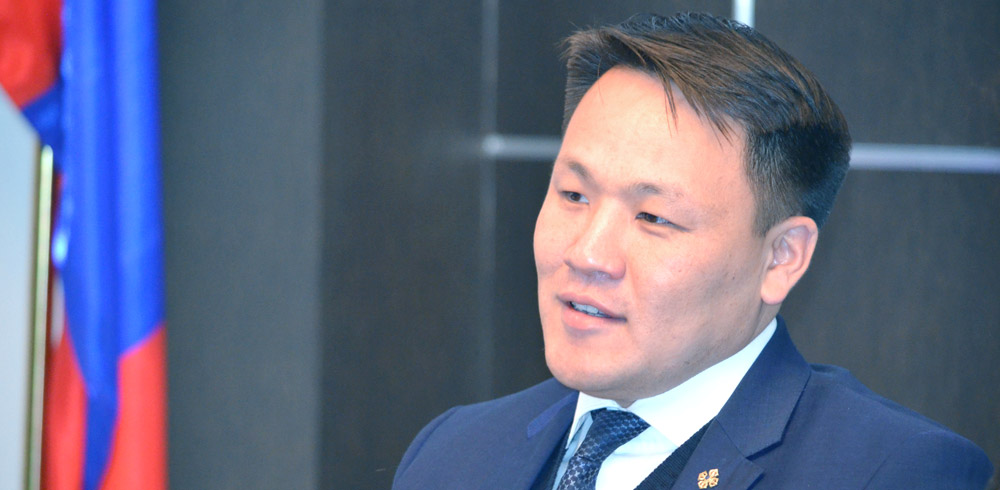
Prominent Mongolian politician arrested ahead of election
Since the fall of communism in 1989 Mongolia has grown into a developed democracy, but alarming signs are beginning to appear. The prominent politician Nomtoibayar Nyamtaishir was arrested, despite the fact that according to Mongolian law he has immunity until the election on June 24.



No comments.
By submitting a comment you grant Free West Media a perpetual license to reproduce your words and name/web site in attribution. Inappropriate and irrelevant comments will be removed at an admin’s discretion. Your email is used for verification purposes only, it will never be shared.